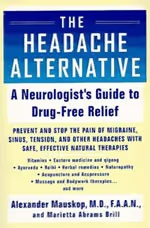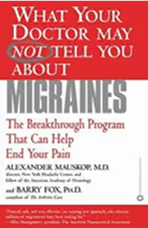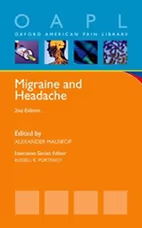Nutrition
NUTRITIONAL ISSUES IN MIGRAINE
An awareness of nutritional issues that may affect migraines can be very helpful in decreasing the occurrence of headaches. People who suffer from migraines should know which foods can potentially trigger headaches, and what types of eating patterns are best for avoiding headaches. Some people know exactly what foods consistently trigger their headaches, but others may not be able to accurately pinpoint their food triggers. Often a food diary is helpful in determining which foods are linked to your migraines.
Eating To Prevent Headaches
The importance of eating regularly cannot be overstated, since skipping meals can trigger headaches. Skipped meals and fasting were reported migraine triggers in more than half of patients surveyed in several studies. Low blood sugar can trigger headaches so it is important to eat breakfast, lunch and dinner everyday. Many people skip breakfast, which puts them at risk for having headaches in the morning. Snacks in the mid-morning and mid-afternoon might also be helpful for people who find that their headaches are often triggered by hunger.
Also, spikes and falls in your blood sugar can trigger headaches. Eating protein and fiber with each meal can help to stabilize the way the food is broken down by your body, thus preventing large fluctuations in blood sugar. For example, having cereal with milk (which has protein) is a better breakfast choice than a big muffin, which is generally high in sugar and low in protein. Protein-rich foods include: meat, fish, poultry, eggs, dairy, beans, and nuts. High-fiber foods include wholegrain breads, whole wheat pastas, bran, fruit (especially dried fruit), green leafy vegetables, and nuts and seeds.
Staying well-hydrated throughout the day is also important, since dehydration can trigger headaches. We recommend drinking 8-10 glasses of water daily to prevent headaches. Caffeinated drinks (coffee, tea, soda) can actually have a dehydrating effect by causing increased urination so these should be limited as much as possible. This is especially important since caffeine also has a role in increasing headaches (see Caffeine section under Identifying Your Triggers).
Identifying Your Triggers
Many migraineurs appear to be very sensitive to certain foods, although the scientific basis for food triggers is controversial. Though the foods and substances discussed below are often identified by patients as headache triggers, not all of the foods will trigger a migraine in any one person. Headaches are generally triggered by a combination of substances, during a time of particular vulnerability (such as menses). Food diaries are helpful in sorting out which ones are problematic for each patient.
Alcohol
Alcohol, especially red wine, is commonly identified as a headache trigger by migraine sufferers. It can either trigger a headache shortly after drinking, or it can cause a hangover headache the next morning. Headaches that occur within several hours after drinking alcohol are probably the result of blood vessel dilation and constriction. Wine also contains substances such as tyramine, histamine, and sulfites, all of which can trigger headaches.
On the other hand, hangover headaches are due to impurities called congeners that are formed as the alcohol is metabolized by the body. Darker colored beverages such as red wine, whiskey, and bourbon have higher levels of congeners than clear drinks such as gin or vodka, and are therefore more likely to cause a hangover headache. Though the severity of the hangover headache generally increases with larger amounts of alcohol consumed, hangover headaches actually occur more often in light or moderate drinkers than in regular heavy drinkers. Drinking in moderation and eating greasy foods prior to drinking may help to decrease the severity of the hangover.
Caffeine
Caffeine is a substance found in coffee, tea, soda, and chocolate. The relationship between caffeine and headaches is a tricky one. When used infrequently in small amounts, caffeine can be very helpful in treating headaches. This is because caffeine has some pain-killing properties, gets to the brain quickly, and helps in the absorption of other medications. That’s why it’s included in over-the-counter headache medications such as Excedrin, and prescription drugs such as Fioricet. However, too much caffeine (usually 2-3 cups of coffee per day) on a regular basis can actually give you more headaches. Even 1 cup of coffee on a daily basis can worsen headaches in some people. If you have a “withdrawal headache” after skipping your usual amount of coffee, then you’re probably drinking too much every day, whether it’s 1 cup or 3 cups.
Food Additives
Food additives that are commonly identified as headache triggers include nitrites and monosodium glutamate (MSG). Nitrates and nitrites are preservatives that are used for food coloring, prevention of food poisoning, and to add a cured or smoked flavor. After eating foods with nitrites, such as sausages or other cured meats and fish including hot dogs, bacon, ham, salami, pepperoni, corned beef, pastrami and lox, some people develop headaches within minutes to hours. Nitrates and nitrites probably trigger headaches by dilating blood vessels. People who are sensitive to these substances should read food labels and avoid foods with sodium nitrite, sodium nitrate, potassium nitrite, or potassium nitrate.
MSG is a flavor enhancer that is most commonly associated with Chinese food. It is also used in meat tenderizer (Accent) and many canned, prepared and packaged foods. MSG is often disguised on food labels as “hydrolyzed vegetable protein (HVP),” “autolyzed yeast,” “sodium caseinate,” “yeast extract,” “hydrolyzed oat flour,” “texturized protein,” or “calcium casinate.” In sensitive patients, MSG can trigger a headache within 30 minutes. Other symptoms may include a hot flush in the chest, neck, and shoulders, dizziness, and abdominal discomfort.
Artificial Sweeteners
Aspartame is an artificial sweetener (NutraSweet ®) that is 180 to 200 times sweeter than regular sugar. Since it became available in 1981, there have been many reports of headaches in connection with its use. The scientific evidence suggests that aspartame may be a headache trigger in people who ingest moderate to high doses (900-3000 mg per day). As a frame of reference, one packet of NutraSweet contains about 36 mg of aspartame. Sucralose is the active component of another common artificial sweetener (Splenda ®). Some case reports have suggested that it may also be a headache trigger. Though many people add artificial sweeteners directly to their coffee or tea, they are actually included in many different foods, such as cereals, breath mints, and even yogurt. People who think they are sensitive to aspartame or sucralose should check food labels for these substances.
Chocolate
The role of chocolate as a headache trigger is a controversial issue. Chocolate and cacao contain phenylethylamine, a substance which may trigger headaches in some migraineurs by altering the size of blood vessels. Chocolate also contains some caffeine, which may trigger headaches. However, some people have cravings for certain foods such as chocolate during a very early stage of migraine called the “prodrome,” which may start up to 48 hours before headache pain begins. In these people, eating chocolate does not trigger the headache- the migraine mechanism has already begun.
Tyramine-Containing Foods
Tyramine is a substance that is found in aged cheese, cured meats, smoked fish, beer, fermented food and yeast extract (including freshly baked bread or cake), among other foods. It probably triggers headaches by constricting blood vessels or by activating some biochemicals in the body that can then set a migraine in motion.
Gluten and migraines
See this blog post about gluten.
.jpg)



This “book” appears to have largely been born out of his blog from the New York Headache Center. For years, he has regularly put up information, scientific and clinical, for his headache followers. He has created this “book,” actually an e-book, which takes relevant information from his experience and knowledge of migraine. There is no need for an index and chapter references. He uses hyperlinks, embedded in the e-book, to connect to material online, which he puts in context for the reader. This works very well as one hyperlink may go to an original paper or publication or a resource site.
He links to major medical journals including headache journals and his own publications, when helpful, as well as nonmedical literature and other sites. This format allows the e-book to be updated from time to time, which is easy to do with this approach.
The book has a very interesting introduction and deals with evidence-based medicine and its role in migraine therapy. When he begins the section on 150+ treatments, he starts with a very interesting comment. Many of the treatment ideas that I describe in this book are not just off-label (that is, not approved by the FDA) but may appear to be off-the-wall. It is refreshing to hear such intellectual honesty from a practicing neurologist.
There is a great section on supplements and finding someone to help with your migraine, such as coach, a partner, or a sympathetic friend. A diagnostic discussion follows and is most helpful, as proper diagnosis directs treatment, as are the detailed sections on triggers including environment, food, exercise, physical therapies, and sleep. Herbal therapies are covered as is neuromodulation and injections/blocks among others.
In the sections on drugs, he deals with acute therapies and the modern use of triptans and gepants, and a ditan. Preventive therapies start with monoclonal calcitonin gene-related peptide antibodies, tricyclic medications, and many other preventive therapies including beta blockers, anti-seizure drugs, nonsteroidal anti-inflammatory drugs, and botulinum injections. From acupuncture to Feldenkrais methods, he covers the contemporary plethora of migraine “treatments” as he sees it in practice.
He ranks all medications on a 1 to 10 scale regarding his own subjective opinions of the utility of each treatment. He indicates that no treatment gets 10 as a score and any receiving a score of 1 were not rated. He also lists his favorite migraine therapies separately. He includes a lot of data links here, from single case reports to full-scale randomized clinical trials, and detailed reviews. His clinical acumen shines through the volume and one gets the impression that this is a very personal view at times, not always backed by evidence, as there may not be any, but by experience, practice and pragmatism. He carefully notes the general things to be careful of in taking some treatments and warns if there are serious concerns. Nonetheless, he indicates clearly that the advice of a medical professional should be sought before trying the therapies mentioned.
Diagnosing secondary headache that can mimic migraine or vice versa is a useful section but does not go into depth about the disorders/diseases mentioned, as this is not the intention of the book. Special circumstances are given sections including menstrual migraine, pregnancy, resistant/refractory headache, aura and headache, and many others.
The author is a senior, highly experienced neurologist and has a high degree of interest in migraine and other headache disorders. He has a sense of curiosity about the brain and migraine and that comes through to the reader of this small volume. I count 23 endorsements, including the excellent foreward of the book from a wide range of well-known people, which includes two prior editors of this journal. He is well liked and highly respected by his colleagues.
In many ways, this book does what online databases on diseases cannot do most times. He tells the reader what he knows and how to use that knowledge. He directs the novice and experts to the right literature and takes the reader on a personal journey through the field of migraine treatments. He tells people, “…keep seeking relief, not to give up on or blame yourself for the pain you experience from migraine.”
There is a printed version of the book; however, the e-book is ideal for the intended purpose. I would recommend it the first instance. It is available via a commercial site and inexpensive.
I would recommend this book to anyone who has migraine or cares for people with migraine and wants a broad and sometimes detailed overview of the treatments. Available in the e-book format, it represents a lot of work for one person, but his passion, occasional humor, and historical perspectives are evident in this work. You don’t have to agree or accept everything the author says to enjoy and benefit from this “book,” and I know he would want people to be critical and skeptical where warranted. However, you will find more than you would usually need to know from this banquet of 150 ways to help your migraines! Enjoy, I did very much. Read it through once and save as reference.
Alexander Mauskop, Director of the New York Headache Center, and Marietta Abrams Brill, a freelance medical writer, have written principally for headache sufferers in North America. They answer questions like “is Rolfing covered by medical insurance?”, and include an excellent resource section in the back. of the book which lists American organizations for the various therapies. But they provide enough background information on both headache and alternative treatments to make their book interesting to readers from other countries, too. In covering most of the more common alternative therapies~like herbs, acupuncture, massage, Ayuverda and Eastern medicine, and qigong-they aim to inform rather than judge, cite research evidence where it exists, and point to potential dangers as well as benefits.
Each of the 10 chapters is introduced with a pithy quote: “Divine is the work to subdue pain” (Hippocrates) heads the first chapter. After general background on pain theories and headache diagnosis, common alternative approaches are covered in turn and there is, of course, oodles of advice on diet and nutrition. A helpful glossary guides readers through words that conventional doctors are familiar with, like Scotoma, and those with which we aren’t, like Qi, Vatta, and Pitta. To round off, a comprehensive resource section and selected bibliography give useful directions to readers wanting more information about specific therapies.
Like all good guides, this one follows a logical structure and so it is relatively simple to go quickly to the information you want to find. It is easy to read. All in all, it is a guide which headache sufferers looking for good information on alternative therapies can be thankful for.
